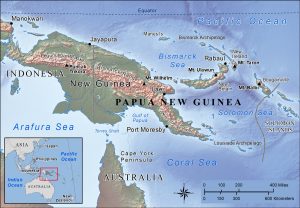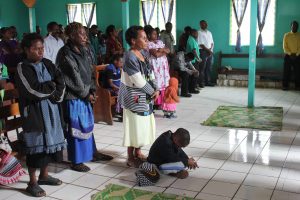20 Pacific Realm: Cultural Geography II – Religion and the Lutheran Faith in Papua New Guinea
This chapter was written by an expert on this particular topic – Y. Franklin Ishida.
Like in many parts of the world, Christianity arrived with the colonial powers in what is now Papua New Guinea, though even that presence was late in coming compared to other lands.
Humans have inhabited New Guinea Island for about 40,000 years. Little was known in Europe about the island until the 19th century. It was only in 1884 that Germany colonized the northeastern portion of the island (called New Guinea) and Great Britain the southeastern portion (Papua). The western half of the island was occupied by the Netherlands and later this was annexed into Indonesia. And while Australia, on behalf of Great Britain, controlled the eastern half for much of the modern era, Papua New Guinea only gained its independence in 1975.
The religious scene followed these colonial markers, with the first German Lutherans establishing themselves at Finschhafen along the east coast of the German Protectorate of New Guinea in 1886. In the southern half, the London Missionary Society (Reformed tradition) arrived in 1889. These two Protestant streams continued to dominate in these two parts of the county, while the Catholic mission started making inroads in the 1880s. Most German missionaries were allowed to remain when Australia took over the German colony after World War I. In the early 1930s Lutheran missionaries were among the first Europeans to move into the highlands.
Today, Lutherans make up about 20% of the population, United Church (originating from the London Missionary Society) 11.5%, Catholics 27%, and Seventh Day Adventists 10%. With other smaller denominations in the mix, a large majority of Papua New Guineans identify themselves as members of a Christian church (96% in the 2000 census). However, many continue to combine their Christian faith with traditional indigenous beliefs and practices, while in places there are strong remnants of what is called Cargo Cult.

The Evangelical Lutheran Church of Papua New Guinea grew out of the work of the Neuendettelsau Mission Society (1886) and the Rhenish Mission Society (1887), both from Germany. During World War II all missionaries left the area, as many mission stations, churches, schools and hospitals were damaged. In spite of this, the indigenous church leaders and local Christians stood firm in the work of the church.
After the war the Lutheran churches in Australia and North America were asked to help reconstruct the church in Papua New Guinea, working together as the Lutheran Mission New Guinea. In 1956 expatriate missionaries and indigenous church leaders gathered and formed the Evangelical Lutheran Church of New Guinea (ELCONG) as an indigenous church. The Lutheran Church Missouri Synod established a separate Gutnius Lutheran Church in the highlands in 1948.
At the time of its founding, ELCONG bishops were expatriate missionaries from the American Lutheran Church. The first indigenous bishop was elected in 1973. In 1975, on the eve of the country’s independence, the name of the church was changed to Evangelical Lutheran Church of Papua New Guinea (ELCPNG). In 1977 the church was officially declared autonomous and another local Lutheran church organized by the Australian Lutheran Mission joined with the ELCPNG.
Since before independence, different churches have operated roughly half of the educational and medical institutions in the country and, to this day, receive government subsidies to provide these services. The ELCPNG operates 170 primary schools and 11 secondary schools, which function on behalf of the government and as public schools. The church also has a teacher training college, (which sends teachers throughout the country), a nursing school, a couple church leadership training colleges, and three theological seminaries.

In response to the rugged and often inaccessible landscape of PNG, Lutherans helped start some key transportation networks. In 1934 a Lutheran mission bought a plane and pioneered mission aviation. While commercial airlines now connect major towns, Mission Aviation Fellowship (MAF), which took over from Lutheran Aviation, continues to link many more remote places.
Mission groups early on also started Lutheran Shipping as a major carrier of cargo and passengers along the north and northeast coasts. Luship, as it was called, ceased operations in 2014, but Lutheran Shipping Services was established by the ELCPNG to continue key shipping routes.
With some 830 different languages in PNG, another challenge is unifying the functions of the church. Like the country at large, Tok Pisin (Pidgin) and English are the common languages of the church, though local indigenous languages are also widely used for worship and teaching.

Although there is no state religion, the preamble to the PNG constitution mentions “the Christian principles” upon which the country is founded. This constitution establishes freedom of religion and religious practice, provided that it does not infringe on the rights of others or of the public interest. Several prime ministers and speakers of parliament have been Lutheran. And with a strong Christian backdrop for the country, the government has pursued programs to increase the partnership between churches and the state, including subsidies to churches and the establishment of church councils to assist in local governance.
Germany had few colonies, but one of those colonial pieces was part of the island of New Guinea. The Lutheran Church, one element of this former colonial rule, remains important in contemporary Papua New Guinea. This denomination has evolved into a national Lutheran church run by New Guineans themselves. Lutherans there seek to improve and renew society spiritually, but also through modernization of educational and transportation systems.
Did You Know?
Cited and additional bibliography:
Wiertz, Steve. 2020. “Papua New Guinea.” College of DuPage GIS class. Instructor Joseph Adduci.


